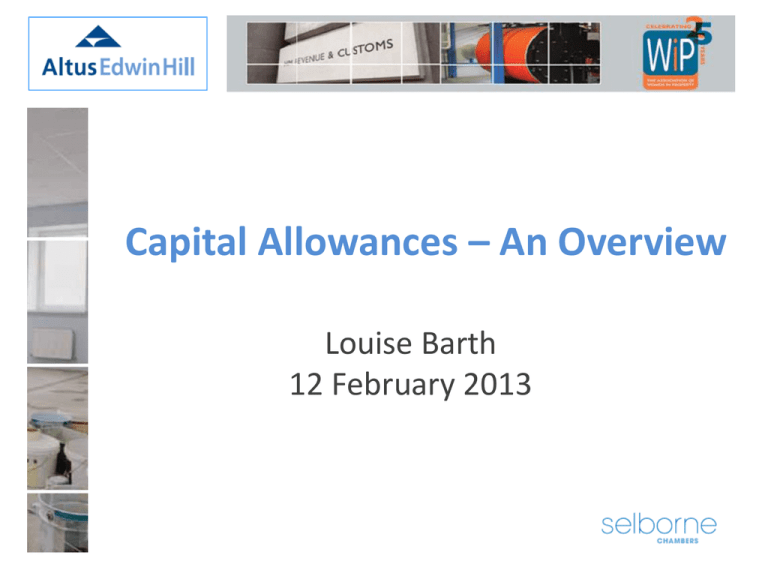Capital Allowances - The Association of Women in Property
advertisement

Capital Allowances – An Overview Louise Barth 12 February 2013 Today’s objectives •Basics – Get the correct tax relief •Mechanics of making a claim •Impact of changes introduced in FA 2012 The Basics •Fixtures •UK Tax relief •Commercial property •Available to all tax payers •Individuals and businesses Property related allowances •Investors •Landlords •Owner occupiers •Tenants •All except residential Two situations 1. Construction •New build •Alteration •Refurbishment •Fit out •Landlord’s contributions 2. Second-hand purchases New construction claims Based on actual costs – quote or final account •Drawings - before and after construction •Specification – scope of works •Variations – adds and omits •Survey •Identify builders work in connection •Base cost asset plus prelims and fees •Total value each fixture Second-hand purchase claims Apportionment purchase price – s562 •HMRC stipulates “Just and reasonable” •Formula approach •3 Components: 1. Land value – bare site 2. Building cost- replacement cost 3. Fixtures cost- replacement cost Three main categories plant & machinery 1. General plant – 18% per annum 2. Integral features – 8% per annum 3. Enhanced capital Allowances – 100% FYA Others to be aware of Long life assets Short life assets BPRA’s IBA’s 1. General plant – 18% per annum • • • • • • • • • • Carpets Signage Sanitary ware Demountable partitions Fire Alarms BMS UPS FF&E Racking Dock levellers 2. Integral features – 8% per annum • • • • • • • Electrical systems Heating Air-conditioning Ventilation Lifts Cold water External solar shading 3. Enhanced Capital Allowances(ECA’s) 100% tax relief in year of expenditure • Encourage green investment • Energy efficient equipment • Water saving technologies • Source equipment from Government list • Energy technology list ( ETL) • Tax credit available 19% if loss making • Boiler controls, lighting, air-con, insulation, rain water harvesting, low flush WC’s How do we go about claiming once we have ascertained the value of the fixtures? •Allowances are pooled according to type •Claimed annually •In a Tax return – not an automatic allowance •Historic claims possible •Allowances not lost What are they worth? £300,000 qualifying expenditure – Corporation tax General plant 18% £ Integral features 8% £ ECA’s 100% FYA £ Total value £ Allowances 100,000 100,000 100,000 300,000 Year 1 WDA 18,000 8,000 100,000 126,000 Cash saving @ 21% 3,780 1,680 21,000 26,460 What are they worth? £300,000 qualifying expenditure – Income tax General plant 18% £ Integral features 8% £ ECA’s 100% FYA £ Total value £ Allowances 100,000 100,000 100,000 300,000 Year 1 WDA 18,000 8,000 100,000 126,000 Cash saving @ 45% 8,100 3,600 45,000 56,700 Pooling allowances Year 1 additions • Purchase claim • Subsequent fit out core areas Year 2 additions • Refurbishment first floor • New carpets Year 3 additions • Refurbishment 5th floor • New CCTV equipment Pool – plant & machinery allowances What happens on sale of the property? •When property changes hands the fixtures are transferred too •A system has been is place since 1990’s which enables us to agree the transfer value, known as the disposal value of the fixtures Joint election – s198 CAA2001 When the seller /prior owner has made a claim: •Seller can keep all the allowances or •Seller can pass all allowances to the Buyer or •They can share the allowances •Disposal value can not exceed original cost •Can not claim twice on same fixture Joint Elections – s198 •Established mechanism – transfer values •Stating values in sale agreement is inadequate •s198 legally binding on both parties, inc HMRC •2 year time limit from date of completion •Must be executed to be valid •Both parties must submit to their Tax Inspector •Excludes contribution allowances •Excludes Chattels S198 Election – draft carefully Name property Interest and Title Date of completion Purchase price £ Name & address seller Name & address buyer Unique tax reference (UTR) Amount fixed by the election £ List Integral features £ List General plant £ When there is no prior claim The buyer is free to make an apportionment claim based upon their purchase price A joint election can only be entered into if a seller has brought a disposal value into account ( made a claim) New Fixtures rules introduced FA2012 Introduction of two requirements that must be satisfied before a buyer can make a claim 1. Statutory Election – s198 2. Mandatory pooling From April 2012 First condition – statutory election If a buyer wants to to make a claim Options: 1. When the seller has made a claim – use election • If agreement cannot be reached – take the matter to a Tax Tribunal 1. When the seller has not claimed – check if prior owner has claimed 2. In the absence of a signed s198 election a written statement must be obtained by the buyer which details the disposal value From April 2012 (continued) If buyer has no use for the allowances, e.g. o/s company or a pension fund, the buyer is advised to take the necessary steps to identify the allowances and establish a disposal value. This will preserve the allowances for a future buyer Failure to do so will preclude all future buyers from claiming on these allowances From April 2012 Property changing hands Invest A Ltd • Purchase • June 2009 • Claim £1M Pension Fund Sells • Purchase • Aug 2012 • S198 • £450K Invest B Ltd Sells • Dec 2013 • S198 • £450k • Pool £450k Purchases completed before April 2012 •Old rules apply •No time limits 1. Owners of fixed plant and machinery should review existing systems and procedures 2. Keep meticulous record of expenditure incurred on fixtures 3. Ability to provide details on disposal From 1 April 2014 Second condition - Pooling requirement In order for a buyer to claim: •Applies to Fixtures purchased on 1 April 2014 onwards •All sellers will be required to pool their expenditure upon disposal •Burden of proof lies with buyer From April 2014 Pooling requirement – Warning! When a seller has not claimed and is not interested in the allowances: •No expenditure has been pooled •S198 not possible •Buyer will not be able to claim •Allowances are lost forever to all future owners •Buyer can not refer the matter to the Tax tribunal – no disposal value to discuss Summary – FA2012 changes 1. Pre April 2012 transfer - old rules 2. April 2012 – 2014 Transitional period First condition has to be met if seller has claimed 3. From April 2014 – two conditions have to be met in order for the buyer/future owner to be able claim 1) Statutory election 2) Mandatory pooling What should we be doing now? •Early involvement – correct tax relief •Correct paperwork •Post 2008 unclaimed allowances- unlock •Timing •Pre – contract DD •Buyer can determine seller’s disposal value •Tax tribunal ?? Louise Barth Louise.barth@altusgroup.com 020 7636 7347 07775 021 1365









